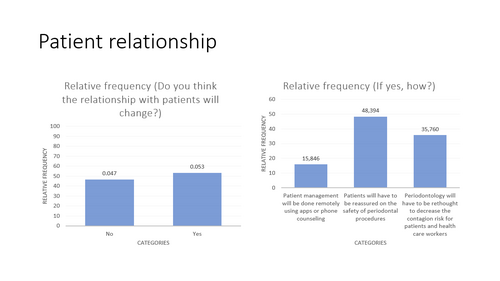
The results of an EFP survey on the initial impact of Covid-19 on the work of periodontists and dental hygienists, conducted between May and August 2020, have been released.
Among the key findings are that nine out of ten periodontists changed their clinical protocols, seven out of ten continued to offer all types of treatment, but almost half ceased offering implant treatment, and just over a third stopped carrying out surgical treatment.
Four out of five hygienists said that they were taking body-temperature measurements of patients and a slightly larger number interviewed or examined patients regarding potential infection with SARS-CoV-2.
Three percent of both periodontists and hygienists reported that they had been infected by the SARS-CoV-2 virus.
The survey was launched by the EFP in May last year to evaluate how much the Covid-19 pandemic was affecting professionals’ daily lives and to find out how they saw the outlook for the future. The questionnaires for periodontists and dental hygienist were provided via the EFP website, with questions covering how clinical protocols had changed, the treatments that were being prioritised, precautions being taken, and the potential long-term economic impact of the pandemic.
The responses (from 798 periodontists and 337 hygienists) showed that since the start of the pandemic:
- 91% of periodontists changed their clinical protocols.
- 70.8% continued to provide all types of treatment, while 27.7% provided only emergency care and 1.5% provided no treatment.
- 80% continued to offer new examinations.
- 82% continued to offer periodontal supportive therapy (SPT).
- Of those that did not provide SPT or provided less of it, 52% offered telephone support to patients, 32.5% adopted a “wait and see” approach, 9.5% offered online support, and 6% sent patients didactic material.
- 46% were no longer performing implant treatment, while 35% were not carrying out surgery, and 16.4% had ceased non-surgical treatment.
Among the dental hygienists:
- 94% changed their clinical protocols.
- 79% continued to provide all SPT, 4.5% provided some SPT, while 16.5% provided none.
- Those that did not provide SPT or provided less of it, 43% offered telephone support to patients, 39% adopted a “wait and see” approach, 13% offered online support, and 5% sent patients didactic material.
- 86% interviewed or examined patients regarding potential infection with SARS-CoV-2 and 80% took body-temperature measurements.
In response to the question, “Do you think that we will return to the pre-epidemic periodontal practice in the future?”, 63% of periodontists said “Yes” and 37% said “No”. More than half (53%) said that they anticipated the relationships with patients would change in the future and of these 48% said that patients will need to be reassured on the safety of periodontal procedures, 36% that periodontology will need to be rethought to decrease the contagion risk for patients and healthcare workers, and 16% that patient management will be done remotely using apps or phone counselling.
Commenting on the results, Filippo Graziani, chair of the EFP European project committee, said: “I believe that the survey highlights how our community swiftly adopted different protocols in order to adapt to the emergency and keep providing treatment to our patients. It is rather remarkable.”
A detailed analysis of the survey’s results will appear in the next issue of the EFP magazine Perio Insight, due to be published later in the spring.




